After being grounded for more than two years, NASA’s shuttle fleet has returned to service with today’s dramatic launch of the space shuttle Discovery. It lifted off right on schedule, at 1439 UTC (10:39 am EDT), and quickly sped up through the light clouds above the Kennedy Space Center. More than 100 cameras were watching the launch from every available angle, and NASA will be examining the photographs carefully to see if any debris fell off the tank and struck the shuttle. Discovery will now link up with the International Space Station in a couple of days.
Measures to Prevent the Contamination of Mars

Crater Holden and Uzboi Vallis. Image credit: ESA/DLR/FU Berlin. Click to enlarge
Over the coming decade, NASA should develop and implement new methods and requirements to detect and eliminate microorganisms on robotic spacecraft sent to Mars to prevent possible contamination of the planet, says a new report from the National Academies’ National Research Council. If microbes aboard a spacecraft were to survive the trip to Mars and grow there, they could interfere with scientific investigations to detect any life that might be native to Mars. Existing techniques for cleaning spacecraft are outdated and typically eliminate only a fraction of microorganisms, said the committee that wrote the report.
Recent scientific findings suggest that liquid water could be present at many locations on Mars and that some organisms on Earth might survive in extreme, Mars-like conditions — such as very low temperatures and high salt concentrations. These discoveries have bolstered the case that Mars could be — or have been — hospitable to life and have created urgency to update policies and practices to prevent Mars contamination, the report says.
“Ongoing Mars missions have shown that the planet may have environments where some Earth microbes could grow,” said Christopher F. Chyba, committee chair and professor of astrophysics and international affairs at Princeton University, Princeton, N.J. “Although we don’t know for sure if this could happen, we need to understand whether liquid water exists in Martian near-surface environments, as well as the nature of microorganisms that are in our clean rooms and spacecraft. It will take a while to carry out the needed research and development, so we need to start in earnest now.”
NASA currently uses screening techniques that detect heat-resistant and spore-forming bacteria on spacecraft and then reduces their numbers by cleaning the spacecraft and, in certain circumstances, baking components with dry heat. But these screening methods are not designed to give a comprehensive tally of the microbes present on the spacecraft, and dry heat can be applied only to spacecraft materials that can withstand high temperatures, the report notes.
NASA should sponsor new research efforts aimed at preventing Mars contamination, the committee said, such as new techniques for detecting biological molecules that do not require time for growing laboratory cultures and could speed spacecraft sterilization and assembly in clean rooms. Also, methods that determine genetic sequences of organisms and link them to known microbial species could allow NASA to tailor sterilization techniques toward spacecraft contaminants of greatest concern. NASA should also investigate alternative cleaning methods — such as the use of radiation or vapor disinfectants — for their effectiveness in killing different types of microorganisms and for their effects on various spacecraft materials.
NASA should develop a certification process to compare detection and cleaning methods and select the most promising ones, begin testing and validating improved techniques within the next three years, and fully implement selected new techniques in time for spacecraft to launch in 2016. Until NASA conducts the research needed to transition to a modern approach for planetary protection, the agency should apply more stringent sterilization levels to all Mars landing spacecraft, the committee said. An independent review panel should be created by NASA and meet every three years to review new knowledge about the Martian environment and recommend updates, as needed, to Mars protection requirements.
The study was sponsored by NASA. The National Research Council is the principal operating arm of the National Academy of Sciences and the National Academy of Engineering. It is a private, nonprofit institution that provide science and technology advice under a congressional charter. A committee roster follows.
Original Source: The National Academies News Release
Strange Ice Boulders on Enceladus
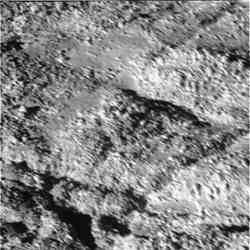
The southern polar terrain of Enceladus. Image credit: NASA/JPL/SSI. Click to enlarge
NASA’s Cassini spacecraft has obtained new, detailed images of the south polar region of Saturn’s moon Enceladus. The data reveal distinctive geological features and the most youthful terrain seen on the moon. These findings point to a very complex evolutionary history for Saturn’s brightest, whitest satellite.
Cassini’s July 14 flyby brought it within 175 kilometers (109 miles) of the surface of the icy moon. The close encounter revealed a landscape near the south pole almost entirely free of impact craters. The area is also littered with house-sized ice boulders carved by unique tectonic patterns found only in this region of the moon.
As white as fresh snow, Enceladus has the most reflective surface in the solar system. Previous Cassini flybys revealed Enceladus, in contrast to Saturn’s other icy moons, has lightly cratered regions, fractured plains and wrinkled terrain.
The new findings add to the story of a body that has undergone multiple episodes of geologic activity spanning a considerable portion of its lifetime. The moon’s southernmost latitudes have likely seen the most recent activity.
These same latitudes may also bear the scars of a shift in the moon’s spin rate. If true, this speculation may help scientists understand why Enceladus has a tortured-looking surface, with pervasive crisscrossing faults, folds and ridges. The most remarkable images show ice blocks about 10 to 100 meters (33 to 328 feet) across in a region that is unusual in its lack of the very fine-grained frost that seems to cover the rest of Enceladus.
“A landscape littered with building-sized blocks was not expected,” said Dr. Peter Thomas, an imaging-team member from Cornell University, Ithaca, N.Y. “The minimal cover of finer material and the preservation of small, crossing fracture patterns in the surrounding areas indicate that this region is young compared to the rest of Enceladus.”
False color composites of this region, created from the most recent images, show the largest exposures of coarse-grained ice fractures seen anywhere on the moon, which also supports the notion of a young surface at southern latitudes. Some of the latest images may hint at the answer. The images revealed additional examples of a distinctive “Y-shaped” tectonic feature on Enceladus. In this unusual element, parallel ridges and valleys appear to systematically fold and deform around the south polar terrains.
“These tectonic features define a boundary that isolates the young, south polar terrains from older terrains on Enceladus,” noted Dr. Paul Helfenstein, an associate of the imaging team also at Cornell University. “Their placement and orientation may tell us a very interesting story about the way the rotation of Enceladus has evolved over time and what might have provided the energy to power the geologic activity that has wracked this moon.”
The apparent absence of sizable impact craters also suggests the south pole is younger than other terrain on Enceladus. All these indications of youth are of great interest to scientists, who have long suspected Enceladus as one possible source of material for Saturn’s extensive and diffuse E ring, which coincides with the moon’s orbit. Young terrain requires a means to generate the heat needed to modify the surface. Other Cassini instrument teams are working to understand data about the temperature, composition, particles and magnetic field. Together with image interpretation, these data can create a more complete picture.
The Cassini-Huygens mission is a cooperative project of NASA, the European Space Agency and the Italian Space Agency. The Jet Propulsion Laboratory, a division of the California Institute of Technology in Pasadena, manages the mission for NASA’s Science Mission Directorate, Washington. The Cassini orbiter and its two onboard cameras were designed, developed and assembled at JPL. The imaging operations center is based at the Space Science Institute in Boulder, Colo.
These Cassini images are available on the Web at: http://www.nasa.gov/cassini , http://saturn.jpl.nasa.gov and http://ciclops.org .
Original Source: NASA/JPL/SSI News Release
SMART-1’s View of Hadley Rille
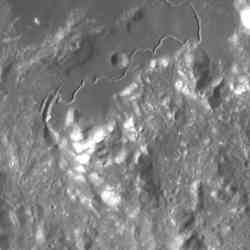
Hadley Rille on the Moon. Image credit: ESA/Space-X. Click to enlarge
This image, taken by the Advanced Moon Micro-Imager Experiment (AMIE) on board ESA?s SMART-1 spacecraft, shows the Hadley Rille on the south-east edge of Mare Imbrium on the Moon.
AMIE obtained this image from an altitude of about 2000 kilometres. It covers an area of about 100 kilometres and shows the region around Hadley Rille centred at approximately 25? North and 3? East.
The sinuous rille follows a course generally to the north-east toward the peak of Mount Hadley, after which it is named (bright feature, top right). To the east of this rille, south-west of Mount Hadley, is Mount Hadley Delta, one of the largest Appenine mountains.
The Appenine mountains mark the edge of the impact basin holding Mare Imbrium, rising between 1800 and 4500 metres above the mare. They are the bright bumps in the lower half of the image.
The valley between these two peaks is fairly well known because NASA astronauts David R. Scott and James B. Irwin landed there during the Apollo 15 mission in 1971. The landing site is near the upper right part of the rille (26.1? North and 3.9? East) on a dark mare plain called Palus Putredinis (Marsh of Decay).
The rille begins at the curved gash on the left side of this image, and is seen clearest in the rectangular, mare-floored valley in the centre of the image. It is over 120 kilometres long, and up to 1500 metres across and over 300 metres deep in places.
The rille formed nearly 3300 million years ago. In contrast, lava channels on Hawaii are usually under 10 kilometres long and are only 50-100 metres wide. The Hadley C crater next to the rille is about 5 kilometres in diameter.
Sinuous rilles are probably the most recognisable of small volcanic features on the Moon. Many partially resemble river valleys on Earth. However, the lunar rilles usually flow away from small pit structures.
The rilles mark lava channels or collapsed lava tubes that formed during mare volcanism. Indeed, the lunar samples indicate that the Moon has always been dry, thus confirming the volcanic origin of the rilles.
Still, in some cases, the lunar flows may have melted their way down into older rocks, much like rivers cut into their flood plains on Earth. Similar lava channels and tubes are found in Hawaii, but these are all much, much smaller than those found on the Moon, indication that the very low lunar gravity has a strong influence on morphological processes.
Original Source: ESA Portal
Galaxy’s Invisible Arms Revealed
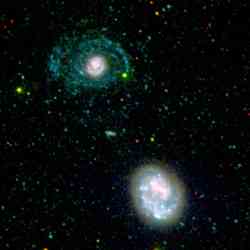
Ultra-violet image of the hidden spiral arms of NGC 4625. Image credit: NASA/JPL/Caltech. Click to enlarge
A new image from NASA’s Galaxy Evolution Explorer shows that a galaxy once thought to be rather plain and old is actually endowed with a gorgeous set of young spiral arms.
The unusual galaxy, called NGC 4625, is a remarkable find because it is relatively nearby. Until now, astronomers had thought that this kind of youthful glow in galaxies was a thing of the past.
“This galaxy is an amazing surprise,” said Dr. Armando Gil de Paz of the Carnegie Observatories, Pasadena, Calif., lead author of a paper appearing in the July issue of Astrophysical Journal Letters. “We are practically up-close and personal with a galaxy undergoing an evolutionary stage that was thought to occur only at the dawn of the universe, in very young and faraway galaxies.”
The image can be found at http://www.nasa.gov/centers/jpl/missions/galex.html or http://www.galex.caltech.edu/ . It offers astronomers their best look yet at what our Milky Way galaxy might have looked like in earlier times.
“We do not fully understand how stars were created in our galaxy,” said Dr. Barry Madore of the Carnegie Observatories, co-author of the new paper. “This nearby galaxy represents one of our possible histories, in which stars developed first in the galaxy core and then later in the arms.”
Previous visible-light images of NGC 4625 showed only an oval-shaped ball of light, with very faint hints of a halo of spiral arms. These arms were finally revealed to the ultraviolet eyes of the Galaxy Evolution Explorer. Their intense brightness indicates that the arms are teeming with hot, newborn stars, which shine primarily with ultraviolet light.
“The stars in the arms are about one billion years old, while the stars in the body are about ten times older,” said Gil de Paz.
NGC 4625’s spiral arms are very lengthy, extending four times beyond the size of the core of the galaxy. They represent the largest ultraviolet galactic disk discovered so far.
Also of interest in the new Galaxy Evolution Explorer image is a nearby companion galaxy, which looks very similar to NGC 4625, yet has no arms. How could this galactic duo have turned out so differently? Astronomers do not know, but some theories hold that the presence of the armless galaxy was required for NGC 4625 to grow a set.
“We know that interactions between galaxies can spur the creation of stars, but it is not clear why only one galaxy ended up with arms,” said Dr. Chris Martin of the California Institute of Technology in Pasadena, Calif, principal investigator for the Galaxy Evolution Explorer.
Previous studies of the gas distribution around the two galaxies indicate that NGC 4625 might have developed in a more dynamically stable environment, while the armless galaxy grew up in a more chaotic and turbulent setting.
Other authors of this paper include: Dr. S. Boissier, Carnegie Observatories; Dr. R. Swaters, University of Maryland, College Park; Dr. R. J. Tuffs, Max Planck Institut fur Kernphysik, Germany; Dr. K. Sheth, Caltech; Dr. R.C. Kennicutt, University of Arizona, Tucson; Drs. L. Bianchi and D. Thilker, Johns Hopkins University, Baltimore, Md.
Caltech leads the Galaxy Evolution Explorer mission and is responsible for science operations and data analysis. NASA’s Jet Propulsion Laboratory, Pasadena, Calif., manages the mission and built the science instrument. The mission was developed under NASA’s Explorers Program managed by the Goddard Space Flight Center, Greenbelt, Md. South Korea and France are the international partners in the mission.
For images and information about the Galaxy Evolution Explorer on the Internet, visit http://www.galex.caltech.edu/ .
Original Source: NASA News Release
Strange Radio Emissions from Saturn
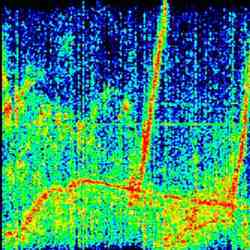
Image depicting radio emissions at Saturn. Image credit: NASA/JPL/University of Iowa. Click to enlarge
Saturn’s radio emissions could be mistaken for a Halloween sound track.
That’s how two researchers describe their recent findings, published in the July 23 issue of the Geophysical Research Letters. Their paper is based on data from the Cassini spacecraft radio and plasma wave science instrument. The study investigates sounds that are not just eerie, but also descriptive of a phenomenon similar to Earth’s northern lights.
“All of the structures we observe in Saturn’s radio spectrum are giving us clues about what might be going on in the source of the radio emissions above Saturn’s auroras,” said Dr. Bill Kurth, deputy principal investigator for the instrument. He is with the University of Iowa, Iowa City. Kurth made the discovery along with Principal Investigator Don Gurnett, a professor at the University. “We believe that the changing frequencies are related to tiny radio sources moving up and down along Saturn’s magnetic field lines.”
Samples of the resulting sounds can be heard at http://www.nasa.gov/cassini , http://saturn.jpl.nasa.gov and http://www-pw.physics.uiowa.edu/cassini/ .
The radio emissions, called Saturn kilometric radiation, are generated along with Saturn’s auroras, or northern and southern lights. Because the Cassini instrument has higher resolution compared to a similar instrument on NASA’s Voyager spacecraft, it has provided more detailed information on the spectrum and the variability of radio emissions. The high-resolution measurements allow scientists to convert the radio waves into audio recordings by shifting the frequencies down into the audio frequency range.
The terrestrial cousins of Saturn’s radio emissions were first reported in 1979 by Gurnett, who used an instrument on the International Sun-Earth Explorer spacecraft in Earth orbit. Kurth said that despite their best efforts, scientists still haven’t agreed on a theory to fully explain the phenomenon.
They will get another chance to solve the radio emission puzzle beginning in mid-2008 when Cassini will fly close to, or possibly even through, the source region at Saturn. Gurnett said, ?It is amazing that the radio emissions from Earth and Saturn sound so similar.?
Other contributors to the paper include University of Iowa scientists George Hospodarsky and Baptiste Cecconi; Mike Kaiser (currently at Goddard Space Flight Center, Greenbelt, Md.); French scientists Philippe Louarn, Philippe Zarka and Alain Lecacheux; and Austrian scientists Helmut Rucker and Mohammed Boudjada.
Cassini, carrying 12 scientific instruments, on June 30, 2004, became the first spacecraft to orbit Saturn. It is conducting a four-year study of the planet, its rings and many moons. The spacecraft carried the Huygens probe, a six-instrument European Space Agency probe that landed on Titan, Saturn’s largest moon, in January 2005.
The Cassini-Huygens mission is a cooperative project of NASA, the European Space Agency and the Italian Space Agency. The Jet Propulsion Laboratory, a division of the California Institute of Technology in Pasadena, manages the Cassini-Huygens mission for NASA’s Science Mission Directorate, Washington. JPL designed, developed and assembled the Cassini orbiter. The radio and plasma wave science team is based at the University of Iowa, Iowa City.
For information on the Cassini mission visit http://saturn.jpl.nasa.gov and http://www.nasa.gov/cassini
Original Source: NASA News Release
Why Are There Smooth Spots on Eros?
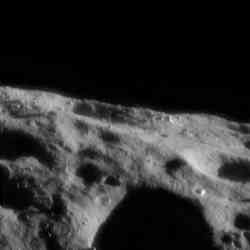
Asteroid 433 Eros taken by NEAR Shoemaker. Image credit: NASA. Click to enlarge
An asteroid’s external features, when analyzed carefully, can say a lot about its interior. So it was while he was mapping the surface of asteroid 433 Eros that Peter Thomas, a senior research associate in astronomy at Cornell University, found a simple solution to an earlier puzzle about the asteroid’s composition.
Thomas was using images collected by the Near Earth Asteroid Rendezvous mission in 2001 to create a digital map of Eros. On the asteroid’s surface, predictably pock-marked with thousands of craters accumulated from impacts over its lifetime, he saw a feature first noticed by Cornell graduate student Marc Berthoud: that a few particular patches were inexplicably smooth. That observation had led to various theories — but none that seemed completely satisfying.
In a letter appearing in the current issue of the journal Nature (Vol. 436, No. 7049, p. 366), Thomas and Northwestern University geologist Mark Robinson show that the asteroid’s smooth patches can be explained by a seismic disturbance that occurred when the crater, known as the Shoemaker crater, was formed.
The fact that seismic waves were carried through the center of the asteroid shows that the asteroid’s core is cohesive enough to transmit such waves, Thomas says. And the smoothing-out effect within a radius of up to 9 kilometers from the 7.6-kilometer Shoemaker crater — even on the opposite side of the asteroid — indicates that Eros’ surface is loose enough to get shaken down by the impact.
Asteroids are small, planetlike bodies that date back to the beginning of the solar system, so studying them can give astronomers insight into the solar system’s formation. And while no asteroids currently threaten Earth, knowing more about their composition could help prepare for a possible future encounter.
Eros, whose surface is a jumble of house-sized boulders and small stones (“what geologists call ‘poorly sorted,'” says Thomas), is the most carefully studied asteroid, in part because its orbit brings it close to earth.
Thomas and Robinson considered various theories for the regions of smoothness, including the idea that ejecta from another impact had blanketed the areas. But they rejected the ejecta hypothesis when calculations showed an impact Shoemaker’s size wouldn’t create enough material to cover the surface indicated. And even if it did, they add, the asteroid’s irregular shape and motion would cause the ejecta to be distributed differently.
In contrast, says Thomas, the shaking-down hypothesis fits the evidence neatly. “The classic light bulb goes on in your head,” he says; the crater density of small craters increases with the distance from the Shoemaker crater. “Simple geometry says something like a simple seismic wave.”
The NEAR mission, in which a NASA spacecraft landed on the asteroid’s surface in 2001 after orbiting it for a year, yielded more than 100,000 images of the small asteroid. (Eros is about 33 kilometers long, 13 kilometers wide and 8 kilometers thick). Since the mission’s conclusion 16 days after the landing, scientists from institutions around the world have been sorting through the data.
That process is expected to continue for years. “Careful mapping of things on the surface can give you a good clue as to what’s inside,” says Thomas. “And in one sense, we’ve barely begun.”
Original Source: Cornell University News Release
Astrophoto: Moon, Jupiter and Spica by Shevill Mathers
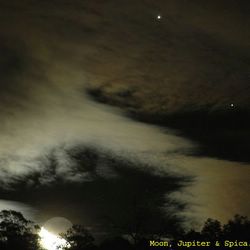
Image credit: Shevill Mathers. Click to enlarge
Astrophoto: Sagittarius Star Cloud by Alonzo Villarreal
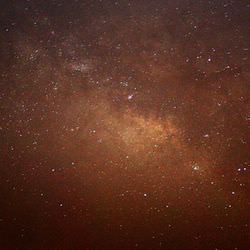
Image credit: Alonzo Villarreal. Click to enlarge
Astrophoto: Lagoon Nebula by Narayan Mukkavilli
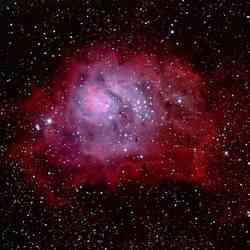
Image credit: Narayan Mukkavilli. Click to enlarge
